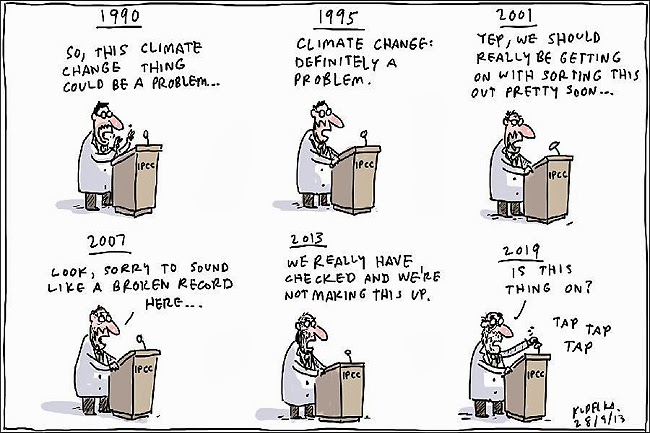The interaction between climate science and policy making is more than a case study - it may literally shape our future world and lives.

The Intergovernmental Panel on Climate Change (IPCC) has now released all three of the reports that comprise its Fifth Assessment Report (AR5). The report from Working Group (WG) I, released in late 2013, tackled the physical changes in the global climate, while the second from WGII addressed climate impacts and adaptation, and the third from WGIII looked at climate change mitigation, published in early 2014. A final synthesis report will be released in October 2014.
While the language may appear inaccessible to some, the Technical Summaries and Summaries for Policymakers are actually quite straightforward to read. For anyone following the development of the IPCC reports, the latest update adds more evidence to support what we already know about climate change and points to a bleaker future without action to address the problem.
Generally there is some friction between those preparing the reports, in their capacity as expert contributors, reviewers and lead authors, and those who write the high level summaries. AR5 is no different, with WG lead authors focusing on the Technical Summary of each report at various speaking events since the launches. The content of the chapters and Technical Summary is not line-by-line reviewed by Governments, however they do nominate reviewers who participate in the overall process. The Summary for Policymakers is line-by-line reviewed by Governments and this leads to some curious differences in focus and language between the two summaries for each report.
Prof David Stern was an author of chapter 5 in WGIII, which dealt with historical trends in emissions. He has speculated as to why countries may not have wanted to include some of the graphs in the summary for policymakers. For example, one graph highlights regional growth in total greenhouse gas (GHG) emissions over the last 40 years, mainly from developing States. Another graph shows that developed States are now responsible for less than half of total historical GHG emissions, while a third graph reveals that the GHG to produce goods in developing States destined for developed States outweigh the emissions created by rich countries to make goods for export elsewhere.
It is not difficult to understand why developed States want to focus on their stabilising or reducing domestic GHG emissions and avoid too much attention on their offshored emissions. The States where these goods are produced equally want to avoid the spotlight of rapidly rising GHG rates. As a result, how we make sense of the science, adaption and mitigation options is crucially important.
The IPCC stagger the release of the reports to allow sufficient time for people to digest their contents. Inevitably the launch events get widespread media coverage and a few days of comment, debate and analysis before the news cycle turns to the next political football. A report by the largest scientific collaboration in history, dealing with global planetary inter-generational challenges then gets relegated behind a story of a football manager’s sacking. When some of those responsible for informing, educating and engaging the public allow implicit comparisons to be made between stories of this nature, is it any surprise that policymakers don’t feel the need, or support, to engage on climate change mitigation policy more earnestly?
The WGI report notes that globally averaged combined land and ocean temperature data shows a warming of 0.85 °C since 1880. Meanwhile, atmospheric concentrations of CO2 continue to rise and the yearly average will soon pass 400 ppm. Twenty four years after the IPCC’s first report, and the creation of the UN Framework Convention on Climate Change (UNFCCC), we are no closer to reaching international agreement on climate policy. The UNFCCC’s Conference of the Parties (COP) meets annually to review measures taken by States and progress made. States have agreed to commit to a maximum temperature rise of 2°C above pre-industrial levels, but there is no agreement on how this should be specifically achieved.
Ahead of COP20 in Lima later this year, the UN Secretary General is hosting a special climate summit in September. Perhaps in response to acrimonious COP meetings in recent years, the UN Secretary General has changed tack and together with leaders of other international UN and other organisations, he has been engaging with civil society, business and other groups to try and create a space for renewed action from policymakers. Leaders from these groups will be joined by Heads of State & Government at the summit in New York to attempt to raise ambitions, catalyse greater action and support policymakers. This is especially important as it is expected that negotiators will use COP20 to begin to firm up language for a new climate change global agreement, including binding GHG emissions targets, to be subsequently finalised at COP21 in Paris, in 2015, taking effect from 2020.
Another unresolved high-profile policy challenge is to deal with aviation GHG emissions within the International Civil Aviation Organization (ICAO). This debate has been particularly fraught and not helped by aeropolitics. However, it is expected that an agreement will be finalised in 2016, also coming into effect from 2020.
This timeline may also compliment parallel discussion on a successor to the UN Millennium Development Goals, i.e. the post-2015 Development Agenda. The original goals refer to poverty, health, education, sustainability and development actions. It will be interesting to see if and how these are linked to climate and sustainability policy.
The IPCC reports have become clearer and more definitive over time. Notwithstanding a vocal minority who are ideologically opposed to climate science and mitigation policies, a broad based coalition has been building momentum for action and to inform the public on the risks we face. Will our political leaders be able to make the necessary decisions, in the face of short term considerations and vested interests in the next 18 months?
This blog first appeared in the IOP Environmental Physics Group newsletter, Summer 2014.
Image source: Kudelka Cartoons